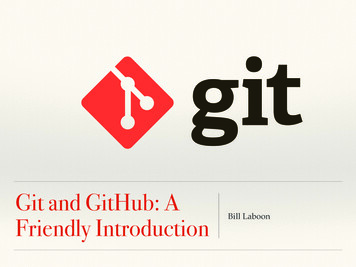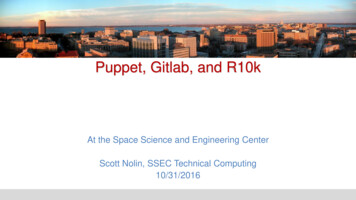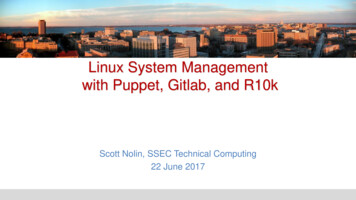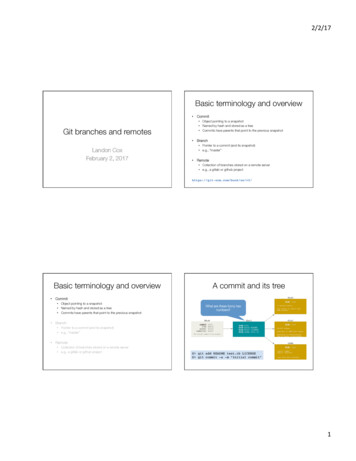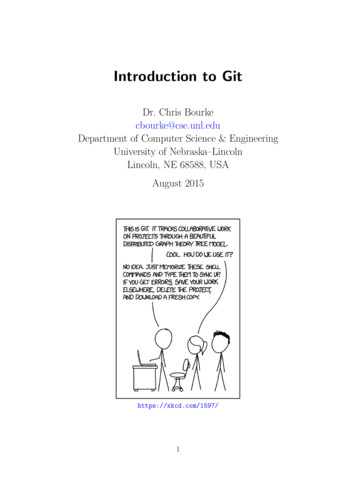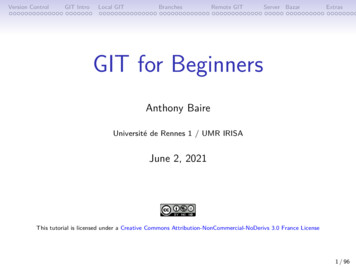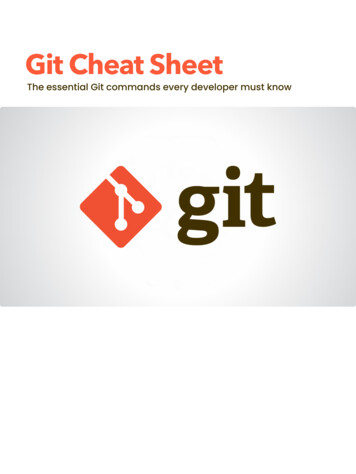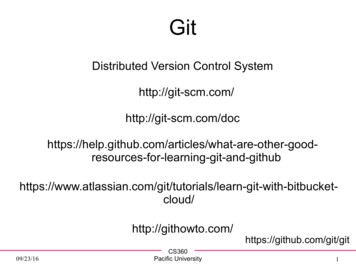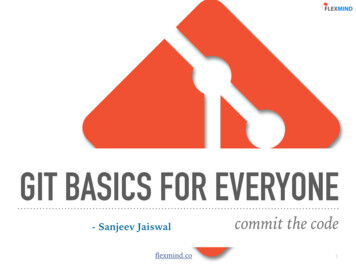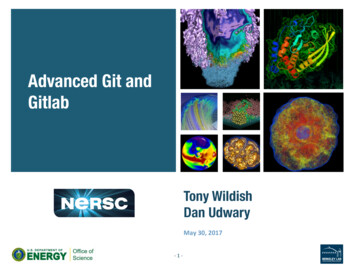
Transcription
Advanced Git andGitlabTony Wildish!Dan UdwaryMay 30, 2017-1-
Advanced Gitlab PrerequisitesBranching and TaggingBuilding mul ple containersPushing images to mul1ple repositoriesUsing metadata in containersDeploying runners on NERSC hostsBest prac ces & recommenda ons Get the code for this tutorial:– Fork the tutorial repository, then clone your fork to your laptop– h@ps://gitlab.com/TonyWildish/gitlab-advanced/-2-
Prerequisites Familiarity with git, docker, gitlab– Git, version 2.11 or higher– Docker, version 1.12.3 or higher– An account on gitlab.com Earlier tutorials:– h@ps://www.nersc.gov/assets/Uploads/Git Docker-Tutorial-Dec01-2016.pdf Do exercises 4 and 5– lab-CI.pdf Do the first ced/-3-
Bonus gitlab tip: Notification emailsGo to your account seXngs,No1fica1ons, Custom-4-
Bonus gitlab tip: Notification emailsChoose any/all fields,can set per-project too-5-
Branching and tagging Branches– Allow parallel development in a single repository– Create branches as needed, delete when obsolete– Can merge branches if you like, or keep forever Bugfix branches: merge, delete the branch Feature branches: keep forever.– Can merge back & forth to control divergenceMasterFeature1Bugfix1-6-“Pro Git”, bySco@ Chacon,Chapter 3
Branching and tagging Tags– Sta1c label, iden1fies a par1cular commit– Easily recover par1cular version at any 1me in future– Once pushed, tags shouldn’t be deleted or moved!Tag1Tag2MasterFeature1Tag3Bugfix1-7-Tag4
Branching and tagging Tags and branches in gitlab– Can be used to iden1fy build products, label images etc If there’s a tag, use that If not, use the branch name ‘master’ branch - ‘latest’ docker version (by conven1on)– Let’s do exercise 8-
Working with forked repositories How do you keep a forked repository up to date?– Add the original source as another ‘remote’ repository git clone git@bitbucket.org:TWildish/jgi-lapinpy.gitCloning into 'jgi-lapinpy'.[ ] cd jgi-lapinpy/ git remote add upstream git@bitbucket.org:berkeleylab/jgi-lapinpy.git git remote -v showorigin git@bitbucket.org:TWildish/jgi-lapinpy.git (fetch)origin git@bitbucket.org:TWildish/jgi-lapinpy.git (push)upstream git@bitbucket.org:berkeleylab/jgi-lapinpy.git (fetch)upstream git@bitbucket.org:berkeleylab/jgi-lapinpy.git (push) git pull upstream masterFrom bitbucket.org:berkeleylab/jgi-lapinpy* branchmaster - FETCH HEADUpda1ng a3f5e1e.03943c8Fast-forward-9-“Pro Git”, bySco@ Chacon,Sec1on 2.5
Working with forked repositories How do you keep a forked repo up to date?– Add the original source as another ‘remote’ repository git clone git@bitbucket.org:TWildish/jgi-lapinpy.gitCloning into 'jgi-lapinpy'.[ ] cd jgi-lapinpy/ git remote add upstream git@bitbucket.org:berkeleylab/jgi-lapinpy.git git remote -v showorigin git@bitbucket.org:TWildish/jgi-lapinpy.git (fetch)origin git@bitbucket.org:TWildish/jgi-lapinpy.git (push)upstream git@bitbucket.org:berkeleylab/jgi-lapinpy.git (fetch)upstream git@bitbucket.org:berkeleylab/jgi-lapinpy.git (push) git pull upstream masterFrom bitbucket.org:berkeleylab/jgi-lapinpy* branchmaster - FETCH HEADUpda1ng a3f5e1e.03943c8Fast-forward- 10 -“Pro Git”, bySco@ Chacon,Sec1on 2.5
Building multiple containers Suppose you have a par cular package with:– A few core dependencies, very small total– Several op1onal extras that add hundreds of MB How do you build an op mal container?– Include everything - baggage that not all users need– Leave stuff out - don’t sa1sfy all users Solu on:– Build two containers (or more) in the same anced/- 11 -
Building multiple containers Gitlab supports building Docker images with namesother than the repository name– Default Docker name structure REGISTRY USER/ APPLICATION: RELEASE TAG– Extended syntax: REGISTRY USER/ APPLICATION/real-name: RELEASE TAG– Use extended syntax repeatedly in .gitlab-ci.yml, withdifferent ‘real-name’s– “myapp-lite” & “myapp”, or “myapp” & “myapp-full”– See exercise 02!h@ps://gitlab.com/TonyWildish/gitlab-advanced/- 12 -
Pushing images to multiple repositoriesGITLAB and SHIFTERvariables point todifferent registry /- 13 -
Pushing images to multiple repositoriesBuild and pushto GITLABRe-tag, push nced/- 14 -
Pushing images to multiple repositories Caveat: Security!– Gitlab hands you a login-token for every build– For shiser, once you’re inside the firewall, there’s noauthen1ca1on needed, so no token– Anywhere else, you probably need a token or password,but where do you store it? Can’t be in the repository, is too visibleHas to be in the runner run1me environment somehowCan do this in SPIN, though not very securely at the momentCan do it on your laptopsWant to do it elsewhere? come for a chat– Exercise 03, in your own 1me Jh@ps://gitlab.com/TonyWildish/gitlab-advanced/- 15 -
Using metadata in containers Pass informa on from the build environment– To the image, or to the user at run1meThanks Mich Tell the user anything they might want to know:––––ael, AlexWhat run1me environment the sosware needsWhat level of tes1ng, cer1fica1on has been performedPointers to documenta1on, source code, maintainers Run1me details: where the container looks for input where it expects to be able to put output metadata-and-container- 16 -
Using metadata in containersDevelopment environmentBuild context (docker daemon)(ARG XYZ XYZ)docker build --build-args XYZ 123How metadata goes from the buildenvironment to the image, and tothe running containerSee Dockerfile.metadata in the repoDocker image(LABEL XYZ XYZ)docker inspect grep XYZRun1me environment (container)(ENV XYZ - 17 -docker run echo XYZ
Using metadata in containers How can we use metadata?– E.g. defining a proper ontology– Automa1ng pipelines, tes1ng, discovery Working group(?) to inves gate this– Probably later in the year aser the migra1on– Volunteers/sugges1ons gratefully accepted!– Exercise 04!h@ps://gitlab.com/TonyWildish/gitlab-advanced/- 18 -
Deploying runners on NERSC hosts A runner at NERSC with write-access to HOME etc? You can do this, but there are serious risks involved!– Don’t share the runner registra1on token with anyone giving them your NERSC password– Don’t give other users master-level access to your repository– Consider alterna1ves: Use a Docker image, with your custom build environment, on SPIN Use a VM somewhere – Talk to a consultant before a@emp1ng this!– Some of these risks are gitlab-specific– Some are inherent in running any internet-enabled ced/- 19 -
Deploying runners on NERSC hosts Basic recipe–––––Download the binary for a gitlab runnerRegister it, give it a host-specific config fileGive it specific tags when registering, to iden1fy itUse those tags in your .gitlab-ci.yml fileYour pipeline can roam over the en1re filesystem if youwant, but it’s up to you then to ensure the directories youuse are clean– See exercise 05 for details – we won’t do this d/- 20 -
Other gitlab features API, programmable interface to Gitlab– h@ps://docs.gitlab.com/ee/api/ See JGI/gitlab-cli-tools repo for some basic tools, contribu1ons welcome! Build hooks– Trigger ac1ons on external services other than gitlab Similar capabili1es on github, bitbucket– Trigger ac1ons in gitlab from external service E.g. nightly build, regardless of commits Mirroring repositories– Master repository in bitbucket/github?– Can mirror to gitlab, automa1cally, transparently Issue-tracking, wiki – Other goodies come for free with gitlab, as with other hos1ng services- 21 -
Best practices, recommendations Git:– Use the fork/pull-request model instead of gran1ngpeople direct-commit access to your repository– Use branches to experiment, try out bugfixes etc Merge long-lived branches frequently to control divergence– Use tags to iden1fy stable versions, releases etc– Don’t delete or move tags once they’re pushed to themaster anced/- 22 -
Best practices, recommendations Gitlab:– Build mul1ple Docker images if you have different usecases to serve from the same code-base– Pushing to mul1ple registries lets users access your imagesfrom many places, easily– Use metadata in your containers! Help us establish standards for JGI container metadata– Control access to your repositories Don’t give out the runner-registra1on token Avoid giving others admin/developer-access to the project Think twice before deploying runners on NERSC nced/- 23 -
Finally You’re all experts now, so update your resumes!– “experience building and op1mizing Docker images forbioinforma1c sosware”– “experience configuring and using con1nuous-integra1onpla orms, such as gitlab, to automate building and deployingsosware”– “in-depth understanding of best-prac1ces for soswaremanagement, such as version control with git and use ofmetadata to describe Docker images”– “understanding of git workflow models for teams, including theuse of branches, tags, and developer lab-advanced/- 24 -
National Energy Research Scientific Computing Center- 25 -
Advanced Gitlab Prerequisites Branching and Tagging Building mulple containers Pushing images to mul1ple repositories Using metadata in containers Deploying runners on NERSC hosts Best prac ces & recommendaons Get the code for this tutorial: – Fork the tutorial repository, then clone your fork to your laptopFile Size: 1MB
